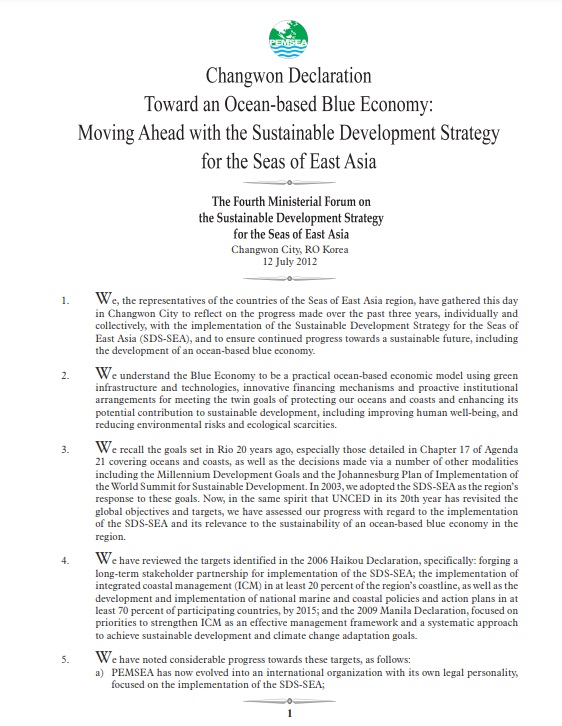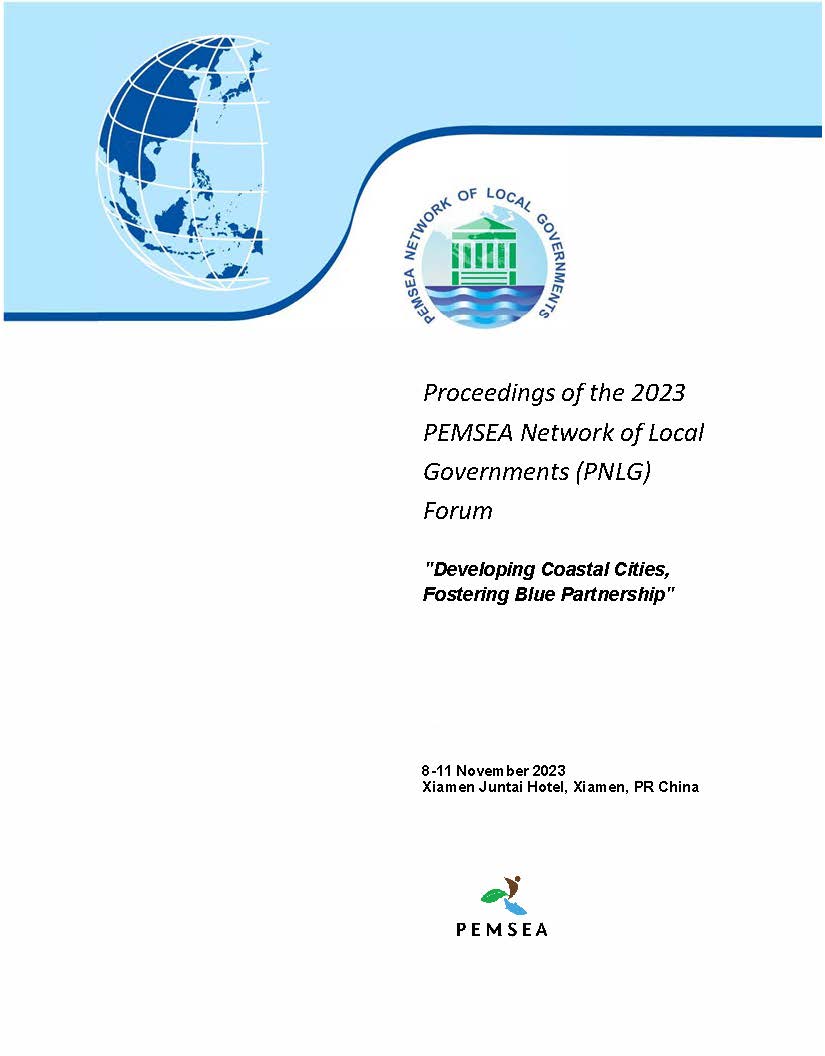
Breadcrumb
Changwon Declaration Toward an Ocean-based Blue Economy : Moving Ahead with the Sustainable Development Strategy for the Seas of East Asia
PRICE:
Free (pay only costs for shipping)
PUBLICATION DATE:
Sunday, July 01, 2012
PUBLICATION TYPE:
Agreements and Publications
STATUS:
Only Available Online
DESCRIPTION:
Signed during the Fourth Ministerial Forum on the Sustainable Development Strategy for the Seas of East Asia on 12 July 2012, the Changwon Declaration reflects on the progress made over the past three years with the implementation of the SDS-SEA, and ensures the continued progress towards a sustainable future, including the development of an ocean-based blue economy. Ministers from 10 countries of the East Asian Seas (EAS) signed the declaration. The Declaration is the region’s support for the implementation of theRio+20 Outcomes embodied in "The Future We Want," and other relevant international and regional commitments related to coasts and oceans. With the signing, Ministers and senior representatives from Cambodia, PR China, Indonesia, Japan, Lao PDR, the Philippines, RO Korea, Singapore, Timor-Leste, and Viet Nam adopted the Five-Year Regional Implementation Plan for the Sustainable Development Strategy for the Seas of East Asia (SDS-SEA) for 2012-2016. Thailand participated as an observer. The Declaration enables the development of an ocean-based blue economy in the region through the strengthened support for SDS-SEA implementation and other relevant initiatives. Under the Changwon Declaration, PEMSEA as the SDS-SEA implementing arm, targets the following changes in coastal and marine governance: (a) a self-sustained regional partnership mechanism for the implementation of the SDS-SEA; and (b) national coastal and ocean policies and supporting institutional arrangements in place in at least 70% of Partner Countries.
RELATED PUBLICATIONS
-
Proceedings of the Thirty Second Meeting of the Executive Committee
The 32nd PEMSEA Executive Committee (EC) Meeting was conducted virtually on 19 March 2024 via Zoom. Participants of the meeting included the EC members , particularly the Chair and Co-Chair, Intergovernmental Session Chair and Co-Chair, the Technical Session Chair of the EAS Partnership Council (PC), and the Executive Director of the PEMSEA Resource Facility (PRF). Observers from the China PEMSEA Center, Ministry of Environment (MoE) of Cambodia, and Department of Environment and Natural Resources (DENR) of the Philippines also attended the meeting. PRF served as the Secretariat of the meeting.
DOCUMENT NUMBER DOCUMENT TITLE EC/32/DOC/01a List of meeting documents EC/32/DOC/01b Provisional agenda EC/32/DOC/02 Updates on the EAS Asian Seas Congress 2024 EC/32/DOC/02a Provisional Structure of the EAS Asian Seas Congress 2024 EC/32/DOC/03 Development of the 8th Ministerial Declaration EC/32/DOC/03a Concept Note and Draft Zero of the 8th MF EC/32/DOC/04 Global Trends and Opportunities Impacting the EAS Region EC/32/DOC/05 Updates on the 16th EAS PC Meeting -
Proceedings of the 2023 PEMSEA Network of Local Governments Forum (PNLG) "Developing Coastal Cities, Fostering Blue Partnership"
The 2023 Forum of the PNLG with the theme, “Developing Coastal Cities, Fostering Blue Partnership” was hosted by the PNLG and PEMSEA and co-organized by the PNLG Secretariat, PEMSEA Resource Facility (PRF) and Coastal and Ocean Management Institute (COMI) of Xiamen University (XMU). The forum was conducted on 8-11 November 2023 in Xiamen, China. The PNLG Forum was one of the key events of the Xiamen World Ocean Week.
The Forum was participated by over 130 participants from:
- 23 members from seven countries, namely: Cambodia, China, Indonesia, Malaysia, Philippines, RO Korea, and Timor Leste,
- 4 PNLG Associate members, namely the First Institute of Oceanography, Ministry of Natural Resources, China; Coastal and Ocean Management Institute (COMI) and Fujian Institute for Sustainable Oceans (FISO) of Xiamen University (XMU), China, and National Ocean Technology Center (NOTC) of the Ministry of Natural Resources, China;
- resource speakers and other invited experts,
- the PNLG Secretariat, and
- the PRF.
-
Proceedings of PEMSEA Network of Learning Centers (PNLC) back - to - back Events
The document contains the proceedings of three back-to-back activities that were conducted in Seoul, Republic of Korea from 31 October to 3 November 2023.
The activities include:
- The 6th Geo Blue Planet Symposium on Digital Solution for Sustainable Ocean Community on October 31
- PEMSEA Learning Exchange on Good Practices in Implementing Biodiversity Conservation-Focused Ecosystem and Area-based Management Approaches on November 1
- The 3rd PEMSEA Network of Learning Centers (PNLC) General Assembly Meeting on November 2
The activities were organized by the PEMSEA Resource Facility (PRF) with support from RoKorea Ministry of Ocean and Fisheries, the Korea Maritime Institute (KMI), and the Korea Management Corporation (KOEM), and the Korea Blue Carbon Research Center.
Participants include 39 representatives from 17 of the 21 PNLC members, officers, and staff from KMI, KOEM, the Korea Blue Carbon Research Center, and the PEMSEA Resource Facility (PRF).





